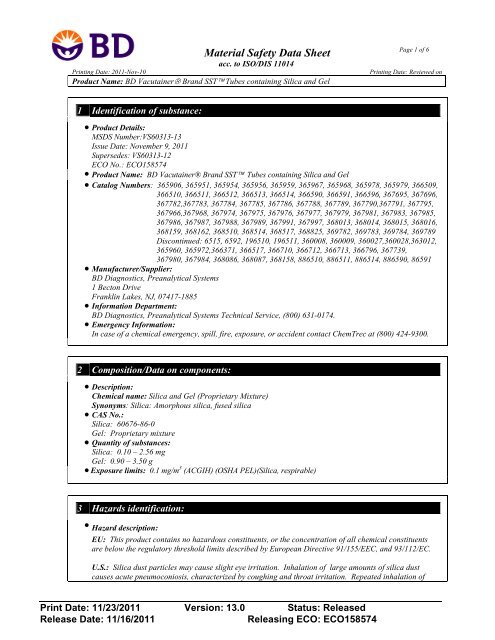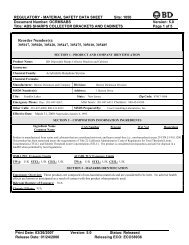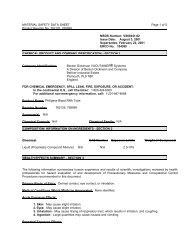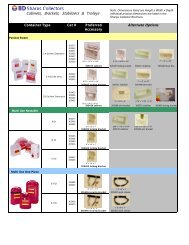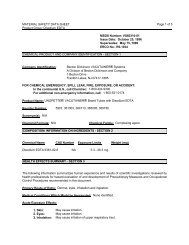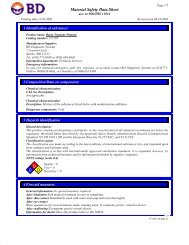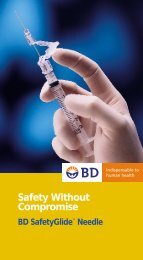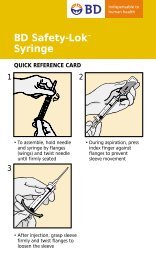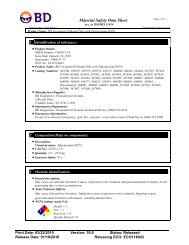MSDS - BD Product Catalog
MSDS - BD Product Catalog
MSDS - BD Product Catalog
Create successful ePaper yourself
Turn your PDF publications into a flip-book with our unique Google optimized e-Paper software.
Printing Date: 2011-Nov-10<br />
Material Safety Data Sheet<br />
acc. to ISO/DIS 11014<br />
<strong>Product</strong> Name: <strong>BD</strong> Vacutainer® Brand SST Tubes containing Silica and Gel<br />
Page 1 of 6<br />
Printing Date: Reviewed on<br />
1 Identification of substance:<br />
• <strong>Product</strong> Details:<br />
<strong>MSDS</strong> Number:VS60313-13<br />
Issue Date: November 9, 2011<br />
Supersedes: VS60313-12<br />
ECO No.: ECO158574<br />
• <strong>Product</strong> Name: <strong>BD</strong> Vacutainer® Brand SST Tubes containing Silica and Gel<br />
• <strong>Catalog</strong> Numbers: 365906, 365951, 365954, 365956, 365959, 365967, 365968, 365978, 365979, 366509,<br />
366510, 366511, 366512, 366513, 366514, 366590, 366591, 366596, 367695, 367696,<br />
367782,367783, 367784, 367785, 367786, 367788, 367789, 367790,367791, 367795,<br />
367966,367968, 367974, 367975, 367976, 367977, 367979, 367981, 367983, 367985,<br />
367986, 367987, 367988, 367989, 367991, 367997, 368013, 368014, 368015, 368016,<br />
368159, 368162, 368510, 368514, 368517, 368825, 369782, 369783, 369784, 369789<br />
Discontinued: 6515, 6592, 196510, 196511, 360008, 360009, 360027,360028,363012,<br />
365960, 365972,366371, 366517, 366710, 366712, 366713, 366796, 367739,<br />
367980, 367984, 368086, 368087, 368158, 886510, 886511, 886514, 886590, 86591<br />
• Manufacturer/Supplier:<br />
<strong>BD</strong> Diagnostics, Preanalytical Systems<br />
1 Becton Drive<br />
Franklin Lakes, NJ, 07417-1885<br />
• Information Department:<br />
<strong>BD</strong> Diagnostics, Preanalytical Systems Technical Service, (800) 631-0174.<br />
• Emergency Information:<br />
In case of a chemical emergency, spill, fire, exposure, or accident contact ChemTrec at (800) 424-9300.<br />
2 Composition/Data on components:<br />
• Description:<br />
Chemical name: Silica and Gel (Proprietary Mixture)<br />
Synonyms: Silica: Amorphous silica, fused silica<br />
• CAS No.:<br />
Silica: 60676-86-0<br />
Gel: Proprietary mixture<br />
• Quantity of substances:<br />
Silica: 0.10 – 2.56 mg<br />
Gel: 0.90 – 3.50 g<br />
• Exposure limits: 0.1 mg/m 3 (ACGIH) (OSHA PEL)(Silica, respirable)<br />
3 Hazards identification:<br />
• Hazard description:<br />
EU: This product contains no hazardous constituents, or the concentration of all chemical constituents<br />
are below the regulatory threshold limits described by European Directive 91/155/EEC, and 93/112/EC.<br />
U.S.: Silica dust particles may cause slight eye irritation. Inhalation of large amounts of silica dust<br />
causes acute pneumoconiosis, characterized by coughing and throat irritation. Repeated inhalation of<br />
Print Date: 11/23/2011 Version: 13.0 Status: Released<br />
Release Date: 11/16/2011 Releasing ECO: ECO158574
Printing Date: 2011-Nov-10<br />
Material Safety Data Sheet<br />
acc. to ISO/DIS 11014<br />
<strong>Product</strong> Name: <strong>BD</strong> Vacutainer® Brand SST Tubes containing Silica and Gel<br />
Page 2 of 6<br />
Printing Date: Reviewed on<br />
silica dust may cause silicosis, a delayed (chronic) lung disease characterized by a severe fibrous scarring<br />
of the lung. Silicosis may be progressive and result in heart failure. Silicosis increases the risk of<br />
tuberculosis, and may lead to chronic kidney disease and end-stage renal disease. Amorphous Silica is<br />
classified by IARC as Group 3 (Not classifiable as to human carcinogenicity.) Avoid inhalation of dusts.<br />
Avoid generation and accumulation of dusts.<br />
Primary route of entry: eyes, inhalation<br />
• Classification system: The classification is according to the latest editions of the EU- list, and extended by<br />
company and literature data.<br />
• Acute Exposure Effects:<br />
Eyes: May cause slight eye irritation.<br />
Skin: None identified.<br />
Inhalation: May cause irritation of the respiratory tract.<br />
Ingestion: None identified.<br />
• Repeated Exposure Effects:<br />
Eyes: May cause slight eye irritation.<br />
Skin: None identified.<br />
Inhalation: Repeated inhalation exposure to silica dust may cause silicosis, a delayed<br />
(chronic) lung disease characterized by a severe fibrous scarring of the lung. Silicosis may be<br />
progressive and result in heart failure. Silicosis increases the risk of tuberculosis, and may lead to<br />
chronic kidney disease and end-stage renal disease.<br />
Ingestion: None identified.<br />
• Medical Conditions Which Might be Aggravated: Pre-existing lung disease<br />
• NFPA ratings (scale 0-4):<br />
Health =2<br />
Fire = 0<br />
Reactivity = 0<br />
Specific Hazard = 0<br />
• HMIS ratings (scale 0-4):<br />
Health =2<br />
Flammability = 0<br />
Reactivity = 0<br />
Special = 0<br />
4 First aid measures:<br />
General information: No special measures required<br />
After inhalation: Remove to fresh air. If not breathing give artificial respiration. If breathing is difficult,<br />
give oxygen. Consult a physician.<br />
After skin contact: Immediately wash with water and soap, and rinse thoroughly<br />
After eye contact: Rinse opened eye for 15 minutes under running water. If symptoms persist, consult a<br />
doctor.<br />
After Swallowing: If large amounts are swallowed, get immediate medical attention.<br />
Information for doctor: Show this label<br />
Print Date: 11/23/2011 Version: 13.0 Status: Released<br />
Release Date: 11/16/2011 Releasing ECO: ECO158574
Printing Date: 2011-Nov-10<br />
Material Safety Data Sheet<br />
acc. to ISO/DIS 11014<br />
<strong>Product</strong> Name: <strong>BD</strong> Vacutainer® Brand SST Tubes containing Silica and Gel<br />
Page 3 of 6<br />
Printing Date: Reviewed on<br />
5 Fire fighting measures:<br />
• Suitable extinguishing agents: Use media suitable for surrounding fire.<br />
• Protective equipment: Wear self-contained NIOSH approved breathing apparatus and protective clothing<br />
to prevent contact with skin and eyes.<br />
6 Accidental release measures:<br />
• Person-related safety precautions: Avoid overexposure. Wear protective equipment, including NIOSH<br />
approved respirator. Exposure limits: 0.1 mg/m 3 (ACGIH)(OSHA PEL)(Silica, respirable)<br />
• Measures for environmental protection: Not applicable<br />
• Measures for cleaning/collecting: Wet down to minimize any airborne dust. Place in an appropriate<br />
disposal container.<br />
• Additional information: None<br />
7 Handling and storage:<br />
• Handling:<br />
Information for safe handling: Follow routine safe handling procedures.<br />
Information about protection against explosions and fires: Not applicable.<br />
• Storage:<br />
Requirements to be met by storerooms and receptacles: Use suitable containers. Keep tightly closed when<br />
not in use. Store in a well-ventilated area.<br />
Information about storage in one common storage facility: Avoid strong oxidizing agents.<br />
Further information about storage conditions: None<br />
8 Exposure controls and personal protection:<br />
• Additional information about design of technical systems: Use sufficient local or general exhaust.<br />
• Components with limit values that require monitoring at the workplace:<br />
Exposure limits: 0.1 mg/m 3 (ACGIH) (OSHA PEL)(Silica)<br />
• Additional information: The lists that were valid during the creation were used as basis.<br />
• Personal Protective Equipment:<br />
General protective hygiene measures: Wash thoroughly after handling. Remove contaminated clothing<br />
and wash before reuse. Avoid contact with eyes, skin, and clothing. Avoid ingestion and inhalation. Use<br />
with adequate ventilation. Provide eye bath and safety shower.<br />
Breathing equipment: NIOSH/MSHA Approved respirator<br />
Protection of hands: Use compatible chemical - resistant gloves<br />
Eye protection: Use chemical safety goggles<br />
Body protection: Wear appropriate protective clothing to prevent skin exposure.<br />
Print Date: 11/23/2011 Version: 13.0 Status: Released<br />
Release Date: 11/16/2011 Releasing ECO: ECO158574
Printing Date: 2011-Nov-10<br />
Material Safety Data Sheet<br />
acc. to ISO/DIS 11014<br />
<strong>Product</strong> Name: <strong>BD</strong> Vacutainer® Brand SST Tubes containing Silica and Gel<br />
Page 4 of 6<br />
Printing Date: Reviewed on<br />
09 Physical and chemical properties:<br />
• General Information:<br />
Form: Gel<br />
Color: Tan<br />
Odor: Odorless<br />
• Change in condition:<br />
Melting point/Melting range: Not determined<br />
Boiling point/Boiling range: Not determined<br />
• Flash point: Not applicable<br />
• Flammability (solid, gaseous): Not applicable<br />
• Danger of explosion: <strong>Product</strong> does not present an explosion hazard.<br />
• Vapor pressure: Not applicable<br />
• Density: Not determined<br />
• Solubility in/Miscibility w/H2 O: Not applicable<br />
• pH-value: Not applicable<br />
Organic solvents: Not applicable<br />
• Solids content: Not available<br />
10 Stability and reactivity:<br />
• Thermal decomposition / conditions to be avoided: None identified<br />
• Materials to be avoided: Strong oxidizing agents<br />
• Dangerous reactions: Stable<br />
• Dangerous products of decomposition: None identified<br />
11 Toxicological information:<br />
• Acute toxicity:<br />
Eye: May cause slight eye irritation.<br />
Skin: None identified.<br />
Inhalation: May cause irritation of the respiratory tract.<br />
Ingestion: None identified.<br />
• Primary irritant effect:<br />
On the skin: Not established<br />
On the eye: Not established<br />
• Sensitization: Not established<br />
• Additional toxicological information:<br />
Chronic: Exposure to silica dust may cause silicosis, a delayed (chronic) lung disease characterized by a<br />
severe fibrous scarring of the lung. Silicosis may be progressive and result in heart failure. Silicosis<br />
increases the risk of tuberculosis, and may lead to chronic kidney disease and end-stage renal disease.<br />
Print Date: 11/23/2011 Version: 13.0 Status: Released<br />
Release Date: 11/16/2011 Releasing ECO: ECO158574
Printing Date: 2011-Nov-10<br />
Material Safety Data Sheet<br />
acc. to ISO/DIS 11014<br />
<strong>Product</strong> Name: <strong>BD</strong> Vacutainer® Brand SST Tubes containing Silica and Gel<br />
Page 5 of 6<br />
Printing Date: Reviewed on<br />
Carcinogenicity: Amorphous Silica is classified by IARC as Group 3 (Not classifiable as to human<br />
carcinogenicity.)<br />
12 Ecological information:<br />
• Ecotoxicological effects: No data is available on the adverse effects of this material on the environment.<br />
Neither COD nor BOD data are available.<br />
• Other information: Not applicable<br />
• General notes: Not applicable<br />
13 Disposal considerations:<br />
• <strong>Product</strong>:<br />
Recommendation<br />
Disposal should be done in accordance with local, state and federal regulations.<br />
Disposal must be made according to the regulations found in 40 CFR 261.<br />
This product is not a RCRA hazardous waste.<br />
• Uncleaned packagings:<br />
Recommendation<br />
Disposal should be done in accordance with local, state and federal regulations.<br />
Recommended cleansing agent<br />
Water, if necessary with cleansing agents<br />
14 Transport information:<br />
• DOT regulations: Not regulated<br />
• Land transport ADR/RID (cross-border): Not regulated<br />
• Maritime transport IMDG: Not regulated<br />
• Air transport ICAO-TI and IATA-DGR: Not regulated<br />
15 Regulations:<br />
• SARA Section 355 (extremely hazardous substances): Substance not listed<br />
• SARA Section 302 (extremely hazardous substances): Substance not listed<br />
• SARA Section 304 (Reportable Quantity (RQ) under CERCLA): None<br />
• Section 313 (specific toxic chemical listings): Substance not listed<br />
• TSCA (Toxic Substances Control Act) Inventory: Silica listed<br />
• California Proposition 65 – Chemicals Known to Cause Cancer: Silica listed; gel component may contain<br />
trace amounts.<br />
California Proposition 65 – Chemicals Known to Cause Reproductive Toxicity: Silica listed<br />
Print Date: 11/23/2011 Version: 13.0 Status: Released<br />
Release Date: 11/16/2011 Releasing ECO: ECO158574
Printing Date: 2011-Nov-10<br />
Material Safety Data Sheet<br />
acc. to ISO/DIS 11014<br />
<strong>Product</strong> Name: <strong>BD</strong> Vacutainer® Brand SST Tubes containing Silica and Gel<br />
Page 6 of 6<br />
Printing Date: Reviewed on<br />
• SARA Section 311/312 (Hazard notification categories under SARA Title III): Acute;Chronic<br />
• Hazardous chemical(s) under OSHA Hazard Communication Standard (29 CFR 1910.1200): Respirable<br />
Amorphous, fused silica listed.<br />
• Carncinogenicity categories<br />
IARC (International Agency for Research on Cancer): Group 3 (Not classifiable as to human<br />
carcinogenicity)<br />
NTP (National Toxicology Program): Amorphous silica not listed<br />
TLV (Threshold Limit Value established by ACGIH): 0.1 mg/m 3 (Silica, respirable)<br />
MAK (German Maximum Workplace Concentration): MAK: 0,3 A mg/m³ (Silica)<br />
• <strong>Product</strong> related hazard information:<br />
• National regulations: Not applicable<br />
• Water hazard class: Not known to be hazardous to water.<br />
16 Other information:<br />
To the best of our knowledge, the information contained herein is accurate. However, neither <strong>BD</strong> or any of<br />
its subsidiaries assumes any liabilities whatsoever for the accuracy or completeness of the information<br />
contained herein. Final determination of suitability of any material is the sole responsibility of the user. All<br />
materials may present unknown hazards and should be used with caution. Although certain hazards are<br />
described herein, we cannot guarantee that these are the only hazards that exist.<br />
• Department issuing <strong>MSDS</strong>: Regulatory Affairs<br />
Print Date: 11/23/2011 Version: 13.0 Status: Released<br />
Release Date: 11/16/2011 Releasing ECO: ECO158574


